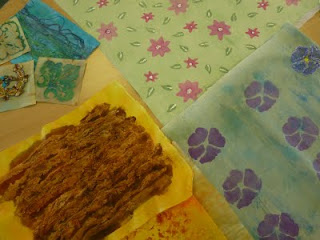The subject of our August 5th meeting was stumpwork, or as it should properly be called, "raised embroidery".
We looked at lots of examples in books and examined in close detail some pieces done by Sheila at Regional Summer School in 2010, in a class with Nicola Hilton. (They weren't finished on the day - Stumpwork is very time consuming!)
Members were then given the chance to have a go themselves, trying either a wrapped bead or a closed or open pea-pod, and we also talked about how to make leaves and petals.
Here are the wrapped beads - they are made from beads with large holes (available from Viking Loom and other outlets) which are then wrapped with a single strand of embroidery thread, using a beading needle or similar, otherwise it won't go through the hole towards the end of the wrapping. To finish, a small bead of the same colour is attached, and the berries are attached to the fabric with a shank (like a button) so that they can "dangle".

To make the open peapod, lay a strip of beads and couch them down so they don't wobble around.
Lay stitches of 6-strand embroidery thread alongside the peas to pad out the pod, then do blanket stitch over the strands, very close together, so that it covers the padding. (There might be a different name for this stitch but that's the gist of it!) Fill in any gaps with satin stitch to give a smooth finish.
 To make the closed pea-pod, draw your outline onto our fabric faintly with pencil. Fill in vertically with 6-strandded cotton, as before, and then use single strands to do blanket stitch and satin stitch to cover the padding.
To make the closed pea-pod, draw your outline onto our fabric faintly with pencil. Fill in vertically with 6-strandded cotton, as before, and then use single strands to do blanket stitch and satin stitch to cover the padding.
The flat leaves on the fabric are made by drawing the outline on the fabric, and doing long and short stitch from the centre of the leaf to the outside. Finish by stitching a vein down the middle of the leaf.
The raised leaves are made on a separate piece of fabric.
First, a piece of fine paper-wrapped florists' wire is formed into the shape of a leaf (or petal) and this is then couched down onto fabric in a hoop, with a few stitches.
Then, very close blanket stitch is done with one strand all around the outline of the leaf, with the smooth edge of the stitch on the outside. Make the stitches very close together, to hide the wire You will find that this looks better when finished, if the wire is the same colour as the thread! You can always colour it in with paint or felt pen before stitching, if you can't find a match. Make sure that you wrap the thread round the wire where the two edges meet and it becomes the stem.
Run a thread through the blanket stitches on the inside of the wired shape which gives an anchor for your filling in stitches, then fill in the centre of the leaf with long and short stitches to the centre, as before, and finish with a line of stitching for the vein.
The final, scary part, is to cut your leaf out of the fabric, cutting as close as you dare to the stitching. If you find that you have white fabric left showing round the edge, trim with VERY sharp scissors and as a last resort, it's back to the felt pen (but that's cheating!)
Attach it to your picture by poking the bare wire stem through the fabric (you may have to make tiny holes with a needle or scissor point) and secure on the reverse with small neat stitches.

And here is a finished article, with detached leaves and petals and wrapped beads.
 Books which are dedicated to the subject usually give good step-by-step instructions and many of the same methods are used for other items - for example, the dragon fly above has wings made in the same way as the leaves, but with a different fabric for the wings, and has a wrapped bead for the abdomen.
Books which are dedicated to the subject usually give good step-by-step instructions and many of the same methods are used for other items - for example, the dragon fly above has wings made in the same way as the leaves, but with a different fabric for the wings, and has a wrapped bead for the abdomen.
Why not browse the new Embroiderers' Guild Bookshop, run by Search Press, at www.egbookshop.com?



















































